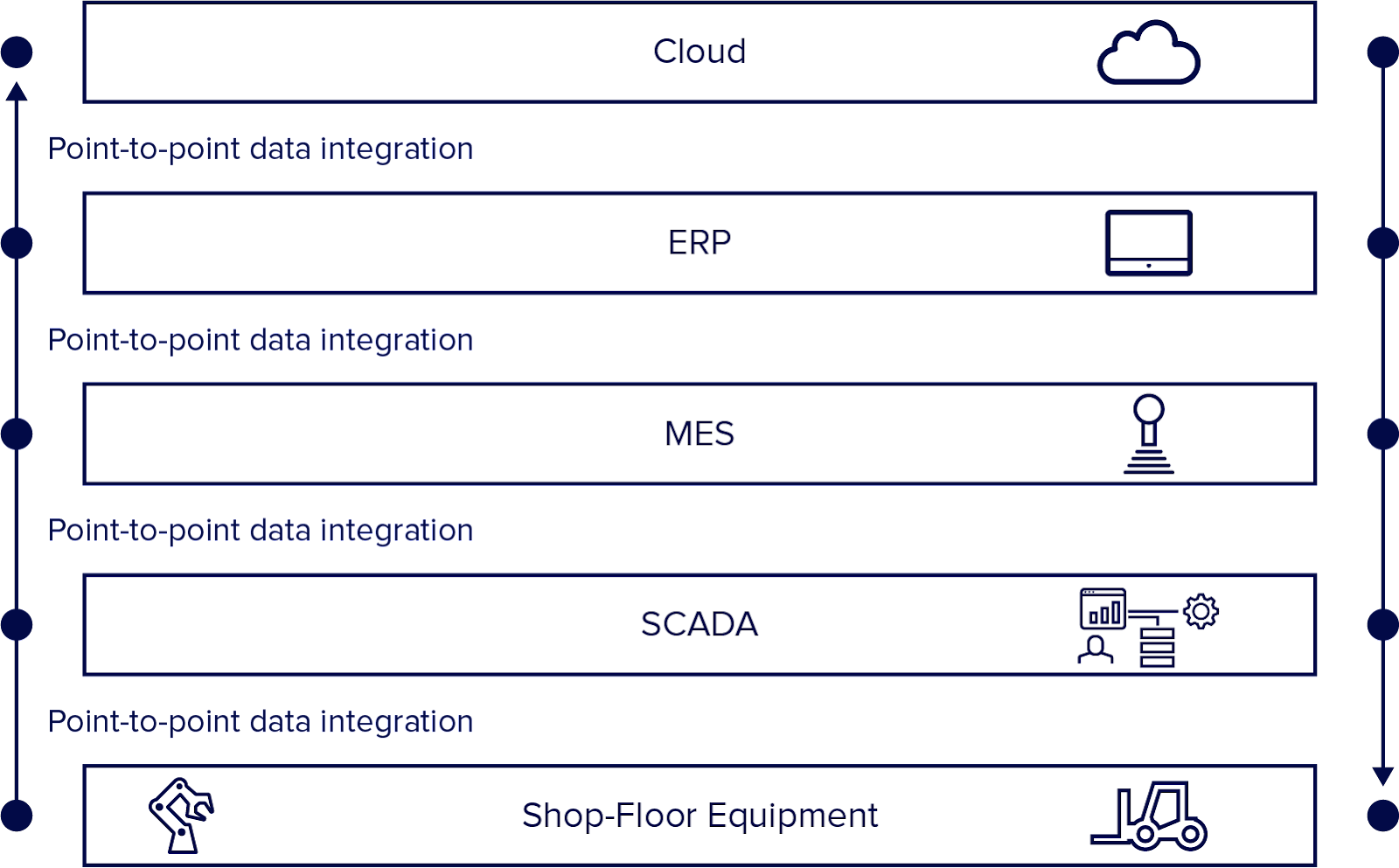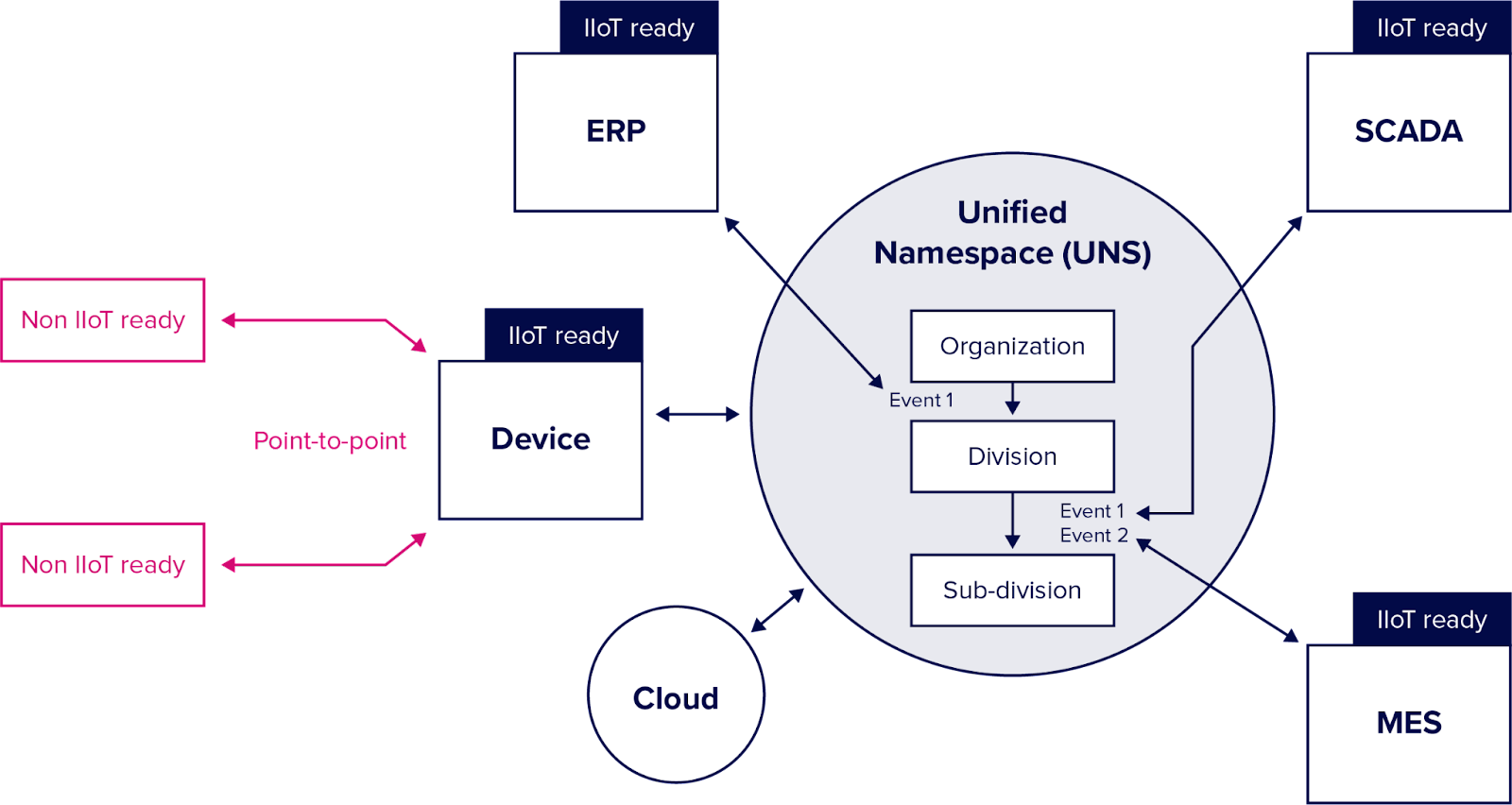The Unified Namespace: Merging OT with IT
|
Getting your Trinity Audio player ready...
|
The unified namespace is the next iteration in the Industrial Internet of Things’ (IIoT’s) digital transformation. A unified namespace is a single source of truth for IIoT data. It combines components from the pyramidal network-and-system ISA 95 functional model with the advanced capabilities of modern cloud software. The unified namespace architecture includes a centralized repository that holds data from each system rather than a formally defined hierarchy.
The ISA-95: a starting point
It’s challenging to explain what a unified namespace is without first discussing its predecessor, the ISA-95.

The ISA-95 functional model got a lot right. Keeping machine controls and devices far from internet connections was and still is a best practice. The point-to-point connections between systems are smart design because they keep systems as safe as possible. The hierarchal design introduced specialty software to factories. Integrating multiple systems meant there didn’t need to be a one-size-fits-all for a plant’s overall control system and day-to-day business activities.
But this model also leaves much to be desired. Communication protocols, data formats, and standards create integration and interoperability complexities between PLC, SCADA, MES, and ERP layers. Data transformations between systems and the many point-to-point data integrations lead to slowdowns in data ingestion and output speed, making real-time decision-making impossible. Additionally, ISA-95 is expensive to implement, doesn’t scale well, and the tightly coupled architecture can make even a small system change challenging.
Take what works and leave the rest
The unified namespace model pushes the foundational idea of ISA-95 forward and improves upon it by cutting out the “middlemen.” Replacing the ISA-95 hierarchy with a unified namespace prioritizes the exchange of information rather than an outdated hierarchical structure.

The unified namespace can live anywhere as long as it’s accessible by every network participant. This means that a unified namespace can connect to the internet and the cloud, but it isn’t required to. A common implementation of a unified namespace architecture is with an MQTT broker. The popular publish/subscribe model that underpins MQTT is also beneficial to a unified namespace because it promotes data exchange between the devices creating data and those that need it. Because not all data applies to all systems and devices, MQTT publishes events from each device to relevant topics, and any applicable system or device can subscribe to those topics to access the event data.
In this setup, data only goes where it needs to and gets there faster. Changing machines or systems becomes easier because the remainder of the architecture doesn’t rely on the other components.
Moving IIoT forward
The benefits of using a unified namespace grow as its characteristics further diverge from those of the ISA-95. The unified namespace’s standardized view makes data accessible across entire organizations, from the people on the plant floor to those in the board room. This promotes a smoother communication and decision-making process. The centralized interface also aids in data standardization and facilitates interoperability.
Of course, with so many devices generating data, it’s critical to have a place to store and manage all that data. Sensors generate time-stamped data (also known as time series data), which has some unique characteristics and workload requirements. Having the right storage solution can make or break your unified namespace project. A traditional relational database quickly breaks down with the volume and velocity of data from industrial devices at scale, and a data historian lacks the connectivity and interoperability to get the full value from your data. A purpose-built, time series database, like InfluxDB, ensures that you can do everything you need to do with your data.
Real-time access to integrated and standardized data—as well as organization-wide viewing accessibility—results in quick, data-driven decision-making, faster anomaly detection, and better analytics and reporting. Reduced redundancy, streamlined data management processes, and minimized system maintenance efforts result in less overhead and simplified maintenance and management.
These improvements lead to a future-proof business. The unified namespace is flexible and scalable. It’s also adaptable to emerging technologies, including new IoT devices, cloud services, and artificial intelligence and machine learning applications. The unified namespace fosters innovation.
Blurring the lines
There would be no unified namespace had ISA-95 not paved the way for this emerging technology. A unified namespace takes the best of ISA-95 and makes it easier for organizations to iterate, try new things, and drive innovation. The barriers between OT and IT become thinner every day, and a unified namespace approach delivers the best of both worlds to the modern industrial organization.
About the author
 This article was written by Jessica Wachtel. She is a Developer Marketing Writer at InfluxData where she creates content that helps make the world of time series data more understandable and accessible. Jessica has a background in software development and technical journalism.
This article was written by Jessica Wachtel. She is a Developer Marketing Writer at InfluxData where she creates content that helps make the world of time series data more understandable and accessible. Jessica has a background in software development and technical journalism.



